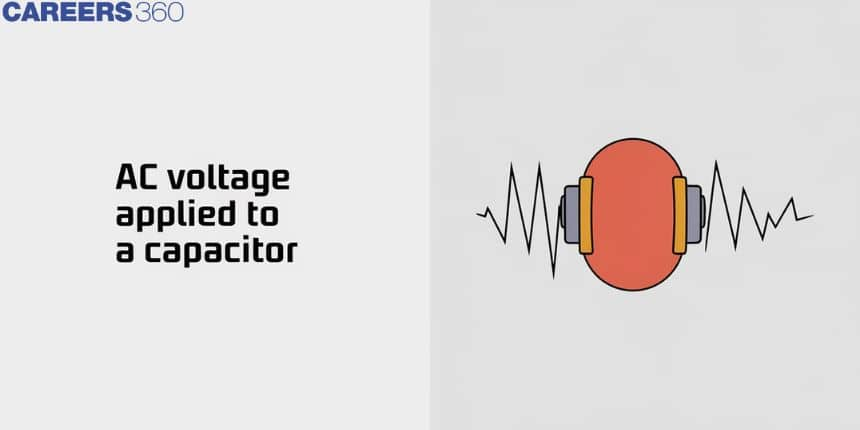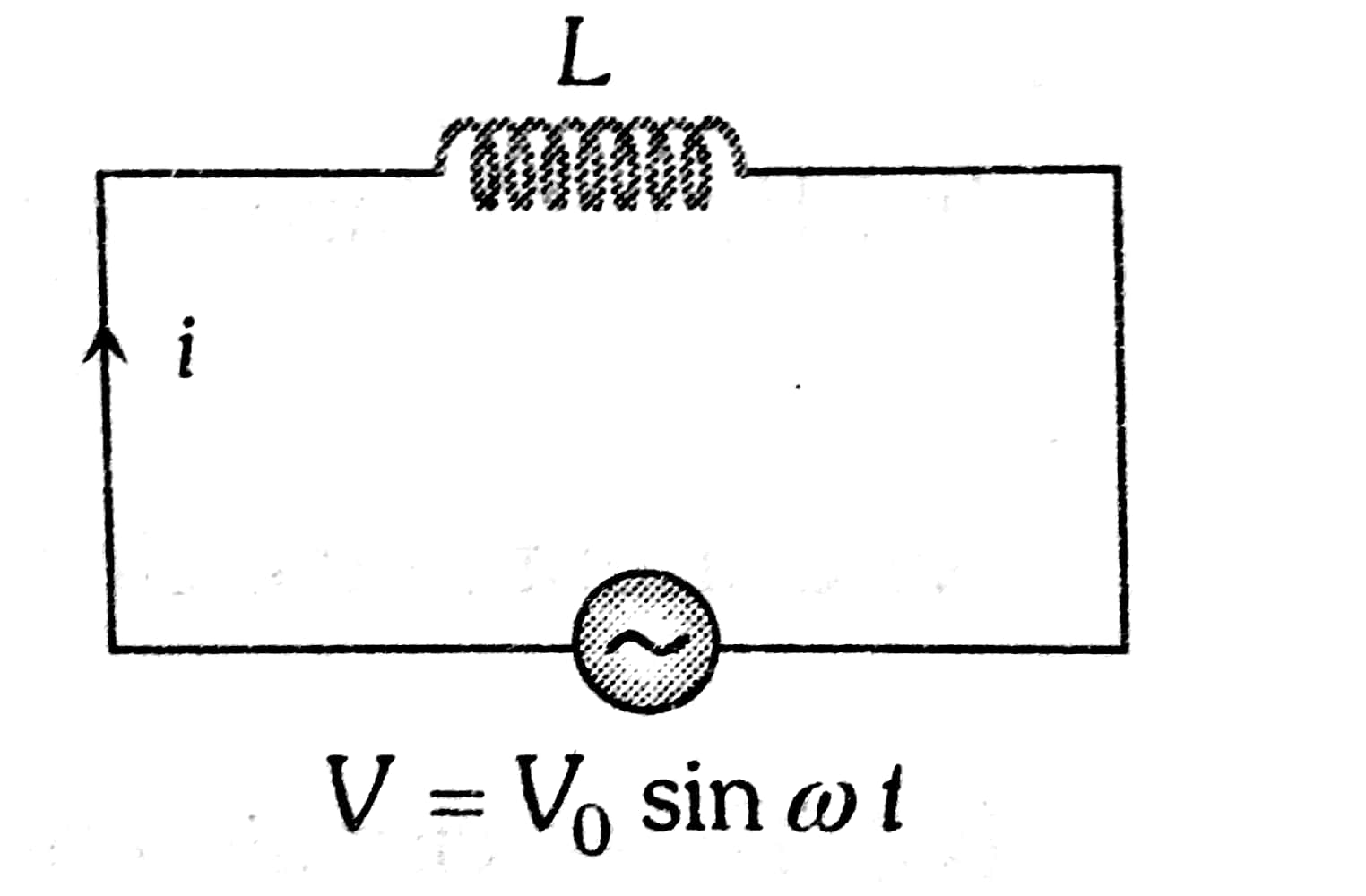AC Voltage Applied To A Capacitor
When an AC voltage is applied to a capacitor, the alternating current creates a constantly changing electric field within the capacitor, causing it to charge and discharge periodically. This behaviour results in a phase difference between the voltage and current, with the current leading the voltage by 90 degrees. Understanding this interaction is fundamental in AC circuit analysis and is widely applied in various technologies. In real life, capacitors are crucial in power supplies for smoothing voltage fluctuations, tuning radios and television circuits for frequency selection, and developing filters for audio and communication systems. This article explores the principles and practical implications of applying AC voltage to a capacitor.
This Story also Contains
- AC Voltage Applied to a Capacitor
- Solved Examples Based on AC Voltage Applied to a Capacitor
- Hence, the answer is the option (1).
- Summary

AC Voltage Applied to a Capacitor
When an AC voltage is applied to a capacitor, the capacitor undergoes a continuous cycle of charging and discharging, responding to the alternating current's oscillations. This results in a phase difference where the current leads the voltage by 90 degrees, a distinctive characteristic in AC circuits. The circuit containing alternating voltage source $V=V_0 \sin \omega t$ is connected to a capacitor of capacitance C.

Suppose at any time t, q is the charge on the capacitor and i is the current in the circuit. Since there is no resistance in the circuit, the instantaneous potential drop $q / C$ across the capacitor must be equal to the applied alternating voltage,
$\frac{q}{C}=V_0 \sin \omega t$
Since $i=d q / d t$ is the instantaneous current in the circuit so,
$\begin{aligned} i= & \frac{d q}{d t}=\frac{d}{d t}\left(C V_0 \sin \omega t\right) \\ & =C V_0 \omega \cos \omega t \\ & =\frac{V_0}{(1 / \omega C)} \cos \omega t \\ & =i_0 \cos \omega t=i_0 \sin \left(\omega t+\frac{\pi}{2}\right)\end{aligned}$
Where, $i_0=\frac{V_0}{(1 / \omega C)}$ is the peak value of current.
Comparing the equation of current with $V=V_0 \sin \omega t$ , we see that in a perfect capacitor current leads the emf by a phase angle of $\pi / 2$.

Again comparing the peak value of current with Ohm's law, we find that quantity 1/ωC has the dimension of the resistance.
Thus the quantity $X_C=\frac{1}{\omega C}=\frac{1}{2 \pi f C}$ is known as capacitive reactance.
Phase difference (between voltage and current):
$\phi=-\frac{\pi}{2}$
Power
P= 0
Power factor
$\cos (\phi)=0$
Time difference
T.D = $\frac{T}{4}$
Recommended Topic Video
Solved Examples Based on AC Voltage Applied to a Capacitor
Example 1: A circuit has a resistance of 12 ohms and an impedance of 15 ohms. The power factor of the circuit will be
1) 0.8
2) 0.125
3) 1.25
4) 0.4
Solution:
R.L Circuit Voltage
$\begin{aligned} & V_R=I R \\ & V_L=I X_L\end{aligned}$
wherein

Power factor
$\cos \phi=\frac{R}{\sqrt{R^2+X_c^2}}$
Solution is correct
Capacitive current (C) Current
$i^{\prime}=i_0^{\prime} \sin \left(\omega t+\frac{\pi}{2}\right)$
wherein

Inductive circuit (L) Current
$i^{\prime}=i_0^{\prime} \sin \left(\omega t-\frac{\pi}{2}\right)$
wherein

Power factor $\cos \phi=\frac{R}{Z}=\frac{12}{15}=0.8$
Hence, the answer is the option (1).
Example 2:

Find peak current (in amperes) is given circuit
1) 0.628
2) 1.34
3) 0.444
4) 0.222
Solution:
Peak Current
$\begin{aligned} & i_0^{\prime}=\frac{v_0}{X_C}=V_0 \omega C=V_0(2 \pi \nu C) \\ & V_{r m s}=\frac{V_o}{\sqrt{2}} \\ & V_o=\sqrt{2} \times V_{r m s} \\ & V_o=\sqrt{2} \times \frac{200}{\sqrt{2}} \\ & V_{\mathrm{o}}=200 \mathrm{mV}\end{aligned}$
Now, peak current,
$
P_o=\frac{V_o}{X_C}
$
$
\begin{aligned}
& i_o=V_o W C=V_o \times 2 \pi f c \\
& i_o=200 \times 2 \times \pi \times 50 \times 10 \times 10^{-3} \\
& i_o=200 \pi \\
& i_o=0.628 \mathrm{~A}
\end{aligned}
$
Hence, the answer is the option (1).
Example 3: Calculate the reactance in the given circuit

1) $\pi$
2) $\frac{2}{\pi}$
3) $2 \pi$
4) $\frac{1}{\pi}$
Solution:
Peak Current
$
i_0^{\prime}=\frac{v_0}{X_C}=V_0 \omega C=V_0(2 \pi \nu C)
$
Capacitive resistance is,
$
\begin{aligned}
& X_C=\frac{1}{\omega C} \\
& \omega=100 \pi \quad C=10 \mathrm{mF} \\
& \quad X_C=\frac{1}{(100 \pi) \times 10^{-2}}=\frac{1}{\pi} \Omega
\end{aligned}
$
Hence, the answer is the option (4).
Example 4: In an a.c. circuit the voltage applied is $E=E_0 \sin \omega t$ The resulting current in the circuit is $I=I_0 \sin \left(\omega t-\frac{\pi}{2}\right)$. The power consumption in the circuit is given by
1) $P=\sqrt{2} E_0 I_0$
2) $P=\frac{E_0 I_0}{\sqrt{2}}$
3) $P=$ zero
4) $P=\frac{E_0 I_0}{2}$
Solution:
The phase difference between voltage and current
$
\phi=90^{\circ}(\text { or }-\pi / 2)
$
Given : $E=E_0 \sin \omega t$
$
I=I_0 \sin \left(\omega t-\frac{\pi}{2}\right)
$
Since the phase difference $(\phi)$ between voltage and current is $\frac{\pi}{2}$ .
$\therefore$ Power factor, $\cos \phi=\cos \frac{\pi}{2}=0$
Power consumption $=E_{\text {rms }} I_{r m s} \cos \phi=0$
Hence, the answer is the option (3).
Example 5: The power factor for the capacitive circuit is
1) 0
2) 1
3) 2
4) none
Solution:
Power Factor
$\cos \phi=0$
The phase difference $(\phi)$ between voltage & current is $90^{\circ}$ in the capacitive circuit:
Power factor, $\operatorname{Cos} \phi=\frac{R}{Z}$
Cos90 = 0
Power factor = 0
Hence, the answer is the option (1).
Summary
When AC voltage is applied to a capacitor, the capacitor charges and discharges in response to the alternating current, creating a phase shift where the current leads the voltage by 90 degrees. This phase difference and the resulting behaviour are crucial for understanding the dynamics of AC circuits. Capacitors influence circuit response by their capacitive reactance, which varies inversely with frequency. Practical applications of this phenomenon include power supply filters, radio and TV tuning, and audio signal processing. Key calculations involve the capacitive reactance and power factor, which determine circuit performance and efficiency.